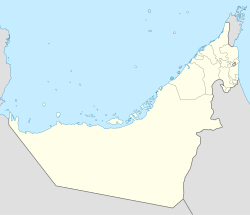193:
35:
181:
205:
42:
131:. Constructed in 1932 by Sheikh Abdullah bin Hamdan Al Sharqi, the fort formed his principle residence for the following two decades. Consisting of a fortified courtyard house and an associated watchtower with commanding views to the East and West of Wadi Hayl, Al Hayl Fort overlooks the old village of
135:, of which many buildings have now been restored. The village was abandoned in the late 1970s following the resettlement of its inhabitants to a new village further down the wadi, a seasonal watercourse, and protected by the Al Hayl Dam. The village was traditionally settled by members of the
167:
and
Fujairah, as well as a builder by the name of Bin Shambi. The buildings are all constructed of gabbro/dolerite rocks bound with a soft mud mortar and faced with plaster. To the interiors, a gypsum plaster was used. The woodwork of the buildings was mangrove with hardwood planking.
192:
143:
described the village, which he named 'Hail' as being located 'inside the hills behind
Fujairah' and consisting of 'around ten houses of Jalajilah and Kunud'), with evidence that the area has been settled since the
163:
In 1932, Sheikh
Abdullah bin Hamdan Al Sharqi constructed the fortified house, a mosque, a majlis and the watchtower. The house was constructed by the Bin Shamal family, builders who worked in
180:
174:
Al Hayl Fort has often been referred to as a summer house, however it was
Abdullah bin Hamdan Al Sharqi's residence until he moved to a house constructed in Mirbah in 1958.
255:
171:
The watchtower at Al Hayl was originally constructed as a residence for Sheikh
Abdullah's younger brother, Suhail, who later moved to a house in the Wadi Furfar.
34:
350:
149:
63:
198:
The Al Hayl Fort
Watchtower, overlooking Hayl Fort and constructed at the same time as the fort. It commands views across the Wadi Hayl.
140:
319:
355:
284:
Ziolkowski, M. C. (May 1998). "A study of the petroglyphs from Wadi al-Hayl, Fujairah, United Arab
Emirates (1)".
236:
Ziolkowski, Michele & Al Sharqi, Abdullah (2006). "Bayt Sheikh
Abdullah bin Hamdan Al Sharqi, Al Hayl".
249:
155:
both found in the area. A number of these are now being threatened by ongoing construction in the area.
186:
The Majlis at Al Hayl, constructed alongside the fort by Sheikh
Abdullah bin Hamdan Al Sharqi in 1932.
128:
98:
124:
145:
301:
293:
204:
297:
344:
152:
305:
78:
65:
120:
108:
132:
271:
Gazetteer of the
Persian Gulf. Vol. II. Geographical and Statistical
164:
136:
104:
94:
21:
8:
254:: CS1 maint: multiple names: authors list (
320:"Progress threatens rare UAE rock drawings"
273:. British Government, Bombay. p. 1696.
18:
221:
176:
93:
58:
27:
16:Place in Fujairah, United Arab Emirates
247:
103:
7:
231:
229:
227:
225:
298:10.1111/j.1600-0471.1998.tb00109.x
14:
351:Forts in the United Arab Emirates
286:Arabian Archaeology and Epigraphy
41:
203:
191:
179:
40:
33:
1:
148:, with Umm Al Nar tombs and
372:
59:
28:
79:25.103619°N 56.287247°E
269:Lorimer, John (1908).
129:United Arab Emirates
99:United Arab Emirates
84:25.103619; 56.287247
75: /
119:is located in the
356:Fujairah articles
146:Umm Al Nar period
123:, to the West of
114:
113:
363:
335:
334:
332:
330:
316:
310:
309:
281:
275:
274:
266:
260:
259:
253:
245:
233:
207:
195:
183:
139:tribe (In 1908,
90:
89:
87:
86:
85:
80:
76:
73:
72:
71:
68:
44:
43:
37:
19:
371:
370:
366:
365:
364:
362:
361:
360:
341:
340:
339:
338:
328:
326:
318:
317:
313:
283:
282:
278:
268:
267:
263:
246:
235:
234:
223:
218:
211:
208:
199:
196:
187:
184:
161:
83:
81:
77:
74:
69:
66:
64:
62:
61:
55:
54:
53:
52:
51:
50:
49:
45:
24:
17:
12:
11:
5:
369:
367:
359:
358:
353:
343:
342:
337:
336:
311:
276:
261:
220:
219:
217:
214:
213:
212:
209:
202:
200:
197:
190:
188:
185:
178:
160:
157:
112:
111:
106:
102:
101:
96:
92:
91:
57:
56:
47:
46:
39:
38:
32:
31:
30:
29:
26:
25:
22:
15:
13:
10:
9:
6:
4:
3:
2:
368:
357:
354:
352:
349:
348:
346:
325:
321:
315:
312:
307:
303:
299:
295:
291:
287:
280:
277:
272:
265:
262:
257:
251:
243:
239:
232:
230:
228:
226:
222:
215:
206:
201:
194:
189:
182:
177:
175:
172:
169:
166:
158:
156:
154:
151:
147:
142:
138:
134:
130:
126:
122:
118:
110:
107:
100:
97:
88:
60:Coordinates:
36:
20:
329:19 September
327:. Retrieved
324:The National
323:
314:
292:(1): 13–89.
289:
285:
279:
270:
264:
250:cite journal
241:
237:
173:
170:
162:
159:Construction
117:Al Hayl Fort
116:
115:
153:petroglyphs
82: /
345:Categories
244:(2): 3–16.
216:References
70:56°17′14″E
67:25°06′13″N
306:0905-7196
210:Hayl Fort
127:, in the
121:Wadi Hayl
48:Hayl Fort
23:Hayl Fort
238:Tribulus
150:Iron Age
125:Fujairah
109:Fujairah
141:Lorimer
133:Al Hayl
105:Emirate
95:Country
304:
165:Kalba
137:Kunud
331:2018
302:ISSN
256:link
294:doi
347::
322:.
300:.
288:.
252:}}
248:{{
242:16
240:.
224:^
333:.
308:.
296::
290:9
258:)
Text is available under the Creative Commons Attribution-ShareAlike License. Additional terms may apply.



